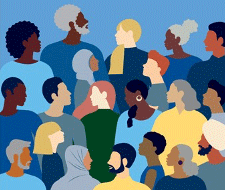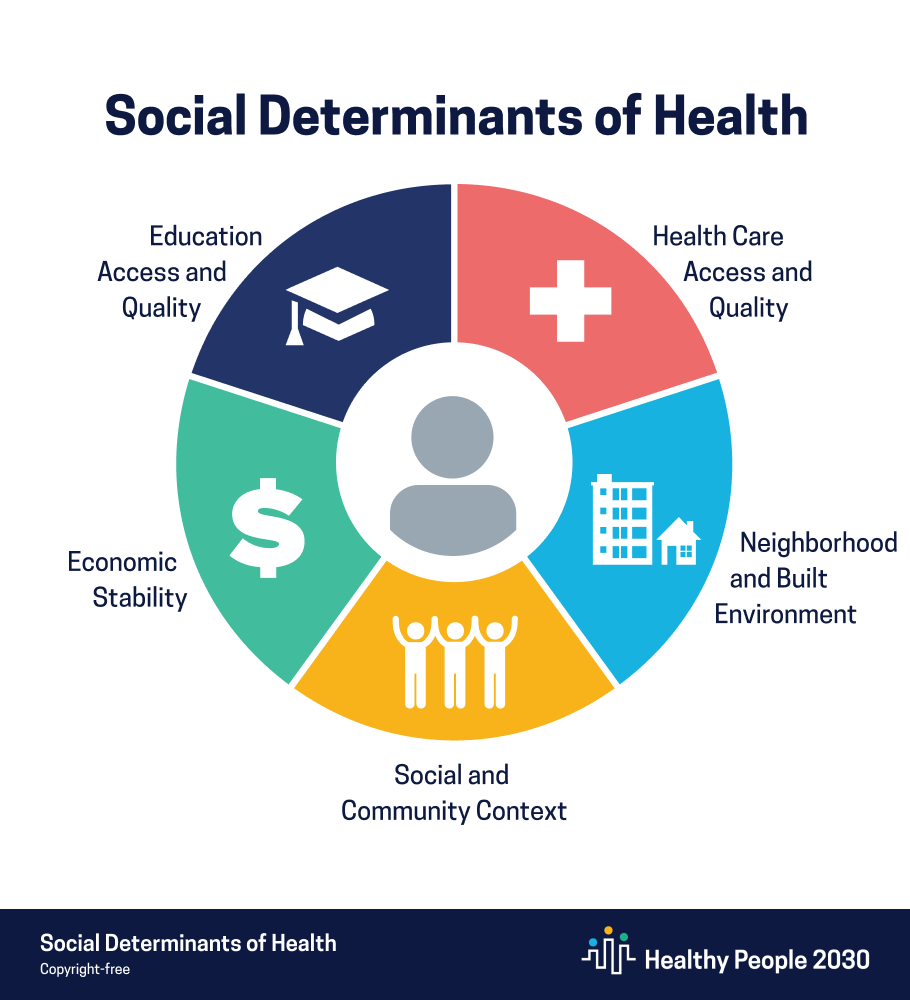Health equity is the absence of unfair, avoidable, or remediable differences in health and well-being among groups of people. It refers to differences in health services related to avoidable social, economic, or other disadvantages. Health inequity, as opposed to health disparities, is an issue of injustice (Lin et al., 2023).
An equitable healthcare system provides all people with equal access to care. This allows all people to attain their full health potential regardless of the color of their skin, ancestry, ethnicity, level of education, gender identity, sexual orientation, age, religion, socioeconomic status, the job they have, the neighborhood they live in, or their ability status (WA State Legislature, 2024).
Test Your Knowledge
You may find it helpful to try these 10 “True or False” questions first before reading the course. The answers are at the end of the question list.
- Implicit bias is a conscious process based on intentional mental associations.
- Health equity means that everyone has a fair and just opportunity to be as healthy as possible.
- Structural racism refers to ideologies, practices, processes, and institutions that produce and reproduce differential access to power and to life opportunities along racial and ethnic lines.
- Cultural sensitivity is a respect for another person’s strengths, culture, and knowledge.
- A type of unconscious bias that occurs when our perception is skewed based on inaccurate and overly simplistic assumptions about a group or person is called perception bias.
- Evidence shows that interventions focusing on social determinants of health rarely lead to better health outcomes.
- Perception bias is a type of unconscious or implicit bias that occurs when our perception is skewed based on inaccurate and overly simplistic assumptions about a group a person “belongs” to.
- Historically embedded structural racism is a fundamental cause of health inequities in the United States.
- Measures of implicit bias rely on the assumption that automatic associations between two concepts will influence behavior in a measurable way.
- Bias training has been shown to be more effective when the approach is multipronged, designed with context and professional identity in mind, and when people work and train together.
Answers: Questions 1 and 6 are False; all the others are True.
Source: NIH.
1.1 How Culture Influences Healthcare Providers and Affects Patients
Culture encompasses the customary beliefs, social forms, and material traits of a racial, religious, or social group. It includes the social behaviors, institutions, and norms found in human societies, as well as the knowledge, beliefs, arts, laws, customs, capabilities, attitudes, and habits of the individuals in these groups. It is also a set of shared attitudes, values, goals, and practices that characterize an institution or organization.

Source: NIH.
Whether you are aware of it or not, culture influences all aspects of healthcare practice, affecting a provider’s perceptions, practices, and decision-making. All forms of knowledge and practice are influenced by culture.
Healthcare providers who are unaware or insensitive to the process by which cultural identity develops can—regardless of their own race or ethnicity—unwittingly minimize the importance of cultural experiences. They can operate from a superior perspective, take a patient’s reactions or disagreements personally, and view a person through a veil of societal biases or stereotypes (SAMHSA, 2016).
Culture is often described as collectivistic or individualistic. Most cultures include characteristics of both, although within any given culture, there are individual variations. Being familiar with characteristics of collectivistic and individualistic cultures can help a provider personalize patient care.
In general, Western countries emphasize the concepts of autonomy and the individual, while Eastern countries tend to emphasize autonomy and community. Some Eastern cultures advocate the ethics of community and of divinity (Bentahila, Fontaine, and Pennequin, 2021).
Characteristics of Collectivistic and Individualistic Cultures | |
|---|---|
Collectivistic | Individualistic |
Focus on “we” | Focus on “I” |
Promote relatedness and interdependence | Value autonomy |
Connection to the family | View ability to make personal individual choices as a right |
Value respect and obedience |
|
Emphasize group goals, cooperation, and harmony | Emphasize individual initiative and achievement |
Greater, broader influence of group views and values | Lesser influence of group views and values, and in fewer aspects of life |
1.2. Creating a Respectful Healthcare Environment
Healthcare organizations and the people who work with those organizations practice respect by recognizing a patient’s value and honoring and acknowledging their dignity. Respect strengthens a clinician’s moral commitment to their patients and has positive effects on health outcomes, patient satisfaction, and mutual trust (Bridges et al., 2021).
Incorporating the perspectives of patients and community members into policies and practices and responding to feedback from patients builds a patient-centered culture of respect. Learning about a patient’s experiences builds clinical partnerships and promotes positive health outcomes (Bridges et al., 2021).
Historical factors have influenced healthcare practices and have contributed to a mistrust of the healthcare system. For example, patients from Indigenous and culturally and linguistically diverse backgrounds frequently report that healthcare staff is disrespectful, unwelcoming, and unfriendly. Healthcare personnel can change this perception by acknowledging their own cultural beliefs, thus working to provide a safe and respectful cultural environment (Kayrouz et al., 2021).
1.3 Morality, Ethics, and Cultural Competence
Morality and ethics play a fundamental role in the functioning of any human society by regulating social interactions and behaviors. They involve a set of values, implicit rules, and principles. This includes long-standing, shared cultural customs that guide social behavior (Bentahila, Fontaine, and Pennequin, 2021).
Understanding moral and ethical practice involves basing decisions on a combination of medical knowledge and moral principles, including beneficence, non-maleficence, autonomy, justice, and respect.
- Beneficence is the act of being kind.
- Non-maleficence means “do no harm.”
- Autonomy is the respect for individual rights and freedoms.
- Justice is the degree to which healthcare services are distributed equitably throughout society as well as how healthcare is delivered at the individual level.
- Respect implies recognizing a patient’s value and honoring or acknowledging their dignity.
The principle of justice is perhaps the most relevant to cultural competence and diversity. It states that people have the right to be treated fairly and equitably. It means respecting the rights of individuals and treating all patients the same regardless of who they are (Olejarczyk and Young, 2024).
Ethical challenges, conflicts, or dilemmas can influence the care and treatment of patients. Placing materialistic self-interest and profit over ethical care is an example of an ethical threat.
Healthcare quality measurements created by insurers, professional organizations, and government agencies can create ethical dilemmas because they often fail to incorporate the voices of diverse communities, leading to a lack of understanding of the needs of the entire population. Until these diverse voices are heard, communities experiencing social injustices caused by historical, racial, and systemic violence will continue to experience healthcare disparities (Culhane-Pera et al., 2021).
1.4 Recognizing Patterns of Healthcare Discrepancies
The COVID-19 pandemic exposed and highlighted disproportionately higher rates of infection, hospitalization, complications, and death faced by racial and ethnic population subgroups. Recent evidence has identified the flaws and adverse outcomes in race-based medicine, where inequities pervade healthcare and influence important management decisions and outcomes (Gallifant et al., 2023).
These disparities are not limited to COVID-19, nor are they entirely represented by race and ethnicity, often involving highly connected, intersectional social determinants of health. While some health disparities are overt, others are introduced and perpetuated inadvertently, such as through differences in the performance of healthcare devices (Gallifant et al., 2023).
There is a significant need for tracking day-to-day markers of disparity that can affect patient care, identifying evolving trends, and assessing the effectiveness of interventions. Initiatives proposed by the Centers for Medicare and Medicaid Services seek to reduce disparities by connecting reimbursements to equitable outcomes. These initiatives require the systematic reporting of patient outcomes in specific subgroups, which, in turn, require the development of infrastructure capable of capturing differences over time and in response to specific interventions (Gallifant et al., 2023).
The first step is to identify disparities by collecting and analyzing data on patient demographics, disease prevalence, and treatment outcomes. Once disparities have been identified, targeted interventions can be developed. For example, a healthcare organization may implement outreach programs to increase access to care for marginalized populations or create targeted treatment plans based on patient data.
Monitoring outcomes for effectiveness is the next step. This involves collecting data on patient outcomes, patient satisfaction, and changes in health disparities over time. Engaging patients is a critical part of improving clinical practice. This involves gathering patient feedback on their experiences with care and incorporating it into decision-making processes.
1.5 Social Determinants of Health
Social determinants of health (SDOH) are “the conditions in the environments where people are born, live, learn, work, play, worship, and age that affect a wide range of health, functioning, and quality-of-life outcomes and risks.” Social determinants provide context for what we experience in our everyday lives. They are not abstract concepts, they are our life circumstances (Reed, 2022).
Social determinants of health are often grouped into 5 domains (Healthy People 2030):
- Healthcare access and quality.
- Neighborhood and the built environment.
- Social and community context.
- Economic stability.
- Education access and quality.
Resources that enhance quality of life, such as safe and affordable housing, access to education, public safety, availability of healthy foods, local health services, and environments free of life-threatening toxins can have a significant influence on population health outcomes.
Social Determinants of Health

Social determinants of health. Source: ODPHP, public domain.
Oppressive systems dictate which people have access to key resources that determine health. Racial discrimination and classism create conditions where people of color, those living in poverty, and other marginalized groups have limited access to resources that impact health (Julian, Hardeman, and Huerto, 2020). Income, education, employment, and housing contribute to 50% of the variability in the length and quality of life and are largely responsible for many observed disparities in health (Towe et al., 2021).
These data are hard to ignore (Towe et al., 2021):
- Black Americans are 5.1 times more likely than white Americans to be incarcerated.
- Black Americans earned 61 cents for every dollar white Americans earned (Hispanic Americans earn 74 cents), disparities which have remained largely unchanged over the last several decades.
- Lower income people are more likely than higher income people to lack access to care and have poorer self-reported general health.
Most Americans are unaware of these health gaps, do not understand what causes them, and do not necessarily find them to be unfair. A national survey conducted in 2008–2009 showed that most respondents (73%) were aware of health differences between the poor and middle-class people, but less than half reported awareness of health differences between white and Black Americans. Additionally, many Americans placed the responsibility for these outcomes on individual behaviors such as smoking, diet, and exercise, as well as access to clinical care as the primary drivers, and less so social determinants of health (Towe et al., 2021).
Social practices such as redlining* and gentrification perpetuate poverty in communities of color in America’s cities. As such, many Black and low-income Americans live in communities where clean water isn’t guaranteed, and social distancing is nearly impossible in crowded homes. In this way, redlining and gentrification impacted the racial inequities seen during the COVID-19 pandemic (Julian, Hardeman, and Huerto, 2020).
*Redlining: a practice in which lenders deny mortgages to eligible buyers solely because of their race.
